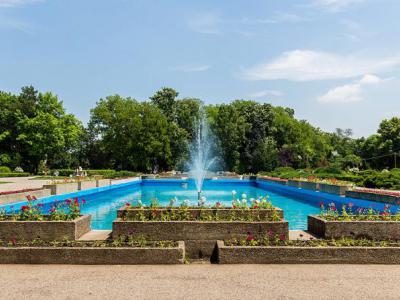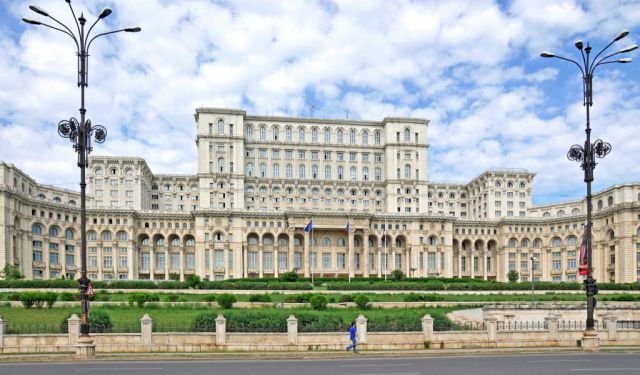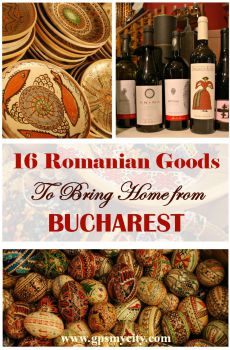
King Michael I Park, Bucharest (must see)
King Michael I Park (Romanian: Parcul "Regele Mihai I"), formerly Herăstrău Park (Romanian: Parcul Herăstrău), is a large park on the northern side of Bucharest, Romania, around Lake Herăstrău, one of the lakes formed by the Colentina River.
The area of the park has been inhabited since the Paleolithic, traces of settlements being found at the Herăstrău sand quarry, including flint tools made by the Mousterian culture, a culture generally associated with the Neanderthals. During the quaternary glaciation, the area was inhabited by large mammals such as the woolly rhinoceros and the mammoth, bones of the latter being found in the Herăstrău sand quarry.
During the Iron Age, a settlement of the first part of the Hallstatt era belonging to a pastoral population was located in Bordei-Herăstrău (the area between Herăstrău and Floreasca lakes, today part of the Herăstrău Park), which gives the name of the culture (Bordei-Herăstrău culture). In the Dacian settlements of Herăstrău, which has been dated, with the help of the coins, to the 1st century BC,archeologists found a treasure containing silver fibulae, silver spiral bracelets, a silver bowl, as well as Ancient Greek coins (from Tomis and Dyrrachium) along with Dacian imitations.
Prince of Wallachia Alexander Ypsilantis built an Ottoman-style pavilion on the banks of the Herăstrău Lake. The plain along the lake was used in 1831, during the Russian occupation, for military exercises by a joint force of the Wallachian and Russian militaries. By the mid-19th century, Herăstrău was the main promenade area used by the Romanian élite for walks.
In 1936, the work began for the creation of the National Park (Parcul Național) in Herăstrău. For this, several dozen squalid houses, as well as an industrial plant were expropriated and torn down, being replaced with alleys and trees, being finally open for the public in May 1939, becoming Bucharest's largest park.
The area of the park has been inhabited since the Paleolithic, traces of settlements being found at the Herăstrău sand quarry, including flint tools made by the Mousterian culture, a culture generally associated with the Neanderthals. During the quaternary glaciation, the area was inhabited by large mammals such as the woolly rhinoceros and the mammoth, bones of the latter being found in the Herăstrău sand quarry.
During the Iron Age, a settlement of the first part of the Hallstatt era belonging to a pastoral population was located in Bordei-Herăstrău (the area between Herăstrău and Floreasca lakes, today part of the Herăstrău Park), which gives the name of the culture (Bordei-Herăstrău culture). In the Dacian settlements of Herăstrău, which has been dated, with the help of the coins, to the 1st century BC,archeologists found a treasure containing silver fibulae, silver spiral bracelets, a silver bowl, as well as Ancient Greek coins (from Tomis and Dyrrachium) along with Dacian imitations.
Prince of Wallachia Alexander Ypsilantis built an Ottoman-style pavilion on the banks of the Herăstrău Lake. The plain along the lake was used in 1831, during the Russian occupation, for military exercises by a joint force of the Wallachian and Russian militaries. By the mid-19th century, Herăstrău was the main promenade area used by the Romanian élite for walks.
In 1936, the work began for the creation of the National Park (Parcul Național) in Herăstrău. For this, several dozen squalid houses, as well as an industrial plant were expropriated and torn down, being replaced with alleys and trees, being finally open for the public in May 1939, becoming Bucharest's largest park.
Sight description based on Wikipedia.
Want to visit this sight? Check out these Self-Guided Walking Tours in Bucharest. Alternatively, you can download the mobile app "GPSmyCity: Walks in 1K+ Cities" from Apple App Store or Google Play Store. The app turns your mobile device to a personal tour guide and it works offline, so no data plan is needed when traveling abroad.
King Michael I Park on Map






Sight Name: King Michael I Park
Sight Location: Bucharest, Romania (See walking tours in Bucharest)
Sight Type: Park/Outdoor
Sight Location: Bucharest, Romania (See walking tours in Bucharest)
Sight Type: Park/Outdoor
Walking Tours in Bucharest, Romania
Create Your Own Walk in Bucharest
Creating your own self-guided walk in Bucharest is easy and fun. Choose the city attractions that you want to see and a walk route map will be created just for you. You can even set your hotel as the start point of the walk.
Bucharest Introduction Walking Tour
Bucharest, the capital and cultural center of Romania, is one of the largest cities in Southeastern Europe.
The name București has an unverified origin. Tradition links it to the guy named Bucur, who (according to various legends) was either a prince, outlaw, fisherman, shepherd or a hunter. The Romanian word “bucurie” means joy (happiness), which in turn explains one of Bucharest's... view more
Tour Duration: 2 Hour(s)
Travel Distance: 3.7 Km or 2.3 Miles
The name București has an unverified origin. Tradition links it to the guy named Bucur, who (according to various legends) was either a prince, outlaw, fisherman, shepherd or a hunter. The Romanian word “bucurie” means joy (happiness), which in turn explains one of Bucharest's... view more
Tour Duration: 2 Hour(s)
Travel Distance: 3.7 Km or 2.3 Miles
Old Town Walking Tour
The Historical Center of Bucharest, or the Old Town, as the locals habitually refer to it, is one of the most beloved and attractive areas in the Romanian capital. The neighborhood is really beautiful a place to visit, and you can walk into it pretty much from anywhere in central Bucharest. Ion Constantin Brătianu Boulevard crosses the historic heart of the city from Piata Universitate... view more
Tour Duration: 2 Hour(s)
Travel Distance: 1.9 Km or 1.2 Miles
Tour Duration: 2 Hour(s)
Travel Distance: 1.9 Km or 1.2 Miles
Useful Travel Guides for Planning Your Trip
16 Uniquely Romanian Things To Buy in Bucharest
Nicknamed "Little Paris", today's Bucharest is the capital of a vibrant European nation, known as Romania, with lots of history and great cultural heritage - spanning from centuries-old rural traditions to New Wave cinema. Keen on rustic stuff, Romanians carefully preserve their...



